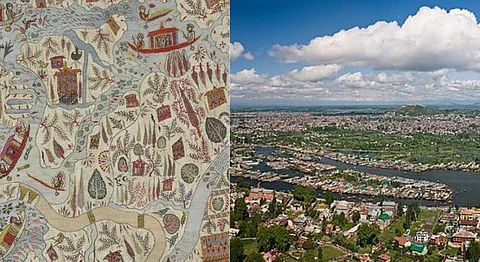
- HOMEGROWN WORLD
- #HGCREATORS
- #HGEXPLORE
- #HGVOICES
- #HGSHOP
- CAREERS
- ABOUT US
- CONTACT US

In the late 19th century, Maharaja Ranbir Singh, the vassal of Kashmir, presented a Map Shawl of Kashmir to Queen Victoria. The embroidered Pashmina shawl (a traditional Kashmiri fabric made from fine goat hair) shows a stylised map of Srinagar, the capital of Kashmir. The shawl is woven with great care given to the detailing of the city’s plans embedded with imagery of houses, mosques, streets and the expanse of the famous Dal Lake and the Jhelum river. It also has tiny inscriptions embroidered in English with the intention of helping identify each building and places of interest. While the intrinsic artwork that took 30 years in making might inspire awe among art lovers, its brutal history cannot be ignored.
The shawl, a courtly gift by Ranbir Singh, is also a testament to his brutal regime – one which oversaw brutality against the Kashmiri Muslim population, of which the shawl-workers were an integral part. In 1865, a workers-led revolt took place to protest for better working conditions for those whose artistry (the shawl workers) was garnering fame worldwide. While the pashmina shawl gifted to the Queen found its way to a museum, the workers were punished and massacred for demanding their rights.
The origins of Kashmir’s shawl industry can be traced back to the Shahmiri rule (1339) but it only garnered global praise during the late period of the Afghan empire. The shawl industry of Kashmir is among the oldest in the world and a testament to the human brilliance of the most skilled artisans and workers in the world. Their excellence and craft might adorn palaces and museums today, but despite their remarkable artistry, the workers of the shawl industry continue to face systematic exploitation at the hands of the government and exporters especially in the past three decades.
The 2019 lockdown imposed by the Indian occupation forces further severed the handicraft trade with 90% losses suffered and with many going into poverty. The indigenous shawl industry of Kashmir has no parallel in the world, as customers and buyers, it is upon us to ethically source Kashmiri handicrafts and save this art from declining into oblivion.
To know more about Kashmir History Project, check out Made In Kashmir.
